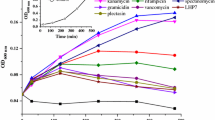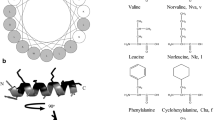Abstract
Lytic peptides are a group of membrane-acting peptides that are active to antibiotic-resistant bacteria but demonstrate high toxicity to tissue cells. Here, we reported the construction of new lytic peptide derivatives through the replacement of corresponding lysine/arginine residues in lytic peptide templates with histidines. Resulting lytic peptides had the same lethality to antibiotic-resistant bacteria, including methicillin-resistant Staphylococcus aureus, but showed greatly improved selectivity to bacteria. When incubated with co-cultured bacteria and tissue cells, these histidine-containing lytic peptide derivatives killed bacteria selectively but spared co-cultured human cells. Membrane insertion and peptide-quenching studies revealed that histidine protonation controlled peptide interactions with cell membranes determined the bacterial selectivity of lytic peptide derivatives. Compared with parent peptides, lytic peptide derivatives bound to bacteria strongly and inserted deeply into the bacterial cell membrane. Therefore, histidine-containing lytic peptides represent a new group of antimicrobial peptides for bacterial infections in which the antibiotic resistance has developed.





Similar content being viewed by others
References
Brown KL, Hancock RE (2006) Cationic host defense (antimicrobial) peptides. Curr Opin Immunol 18:24–30
Cherepanov DA, Feniouk BA, Junge W, Mulkidjanian AY (2003) Low dielectric permittivity of water at the membrane interface: effect on the energy coupling mechanism in biological membranes. Biophys J 85(2):1307–1316
Chung LA, Lear JD, DeGrado WF (1992) Fluorescence studies of the secondary structure and orientation of a model ion channel peptide in phospholipid vesicles. Biochemistry 31(28):6608–6616
Coates AR, Halls G, Hu Y (2011) Novel classes of antibiotics or more of the same? Br J Pharmacol 163(1):184–194
Dempsey CE (1990) The actions of melittin on membranes. Biochim Biophys Acta 1031:143–161
Den Hertog AL, Wong Fong Sang HW, Kraayenhof R, Bolscher JG, Van’t Hof W, Veerman EC, Nieuw Amerongen AV (2004) Interactions of histatin 5 and histatin 5-derived peptides with liposome membranes: surface effects, translocation and permeabilization. Biochem J 379:665–672
Deslouches B, Islam K, Craigo JK, Phadke SM, Montelaro RC, Mietzner TA (2005) Activity of the de novo engineered antimicrobial peptide WLBU2 against Pseudomonas aeruginosa in human serum and whole blood: implications for systemic applications. Antimicrob Agents Chemother 49:3208–3216
Dimarcq JL, Bulet P, Hetru C, Hoffmann J (1998) Cysteine-rich antimicrobial peptides in invertebrates. Biopolymers 47:465–477
French GL (2010) The continuing crisis in antibiotic resistance. Int J Antimicrob Agents 3:S3–S7
Goldman MJ, Anderson GM, Stolzenberg ED, Kari UP, Zasloff M, Wilson JM (1997) Human beta-defensin-1 is a salt-sensitive antibiotic in lung that is inactivated in cystic fibrosis. Cell 88(4):553–560
Hansel W, Enright F, Leuschner C (2007) Destruction of breast cancers and their metastases by lytic peptide conjugates in vitro and in vivo. Mol Cell Endocrinol 260–262:183–189
Helmerhorst EJ, Reijnders IM, Hof WV, Veerman ECI, Amerongen AVN (1999) A critical comparison of the hemolytic and fungicidal activities of cationic antimicrobial peptides. FEBS Lett 449:105–110
Jin Y, Mozsolits H, Hammer J, Zmuda E, Zhu F, Zhang Y, Aguilar MI, Blazyk J (2003) Influence of tryptophan on lipid binding of linear amphipathic cationic antimicrobial peptides. Biochemistry 42(31):9395–9405
Kharidia R, Liang JF (2011) The activity of a small lytic peptide PTP-7 on Staphylococcus aureus biofilms. J Microbiol 49:663–668
Kirkpatrick Daniel T, Guth Daniel J, Mavis RichardD (2006) Detection of in vivo lipid peroxidation using the thiobarbituric acid assay for lipid hydroperoxides. J Biochem Toxicol 1:93–104
Lee C (2008) Therapeutic challenges in the era of antibiotic resistance. Int J Antimicrob Agents 4:S197–S199
Leuschner C, Hansel W (2004) Membrane disrupting lytic peptides for cancer treatments. Curr Pharm Des 10(19):2299–2310
Ludtke SJ, He K, Heller WT, Harroun TA, Yang L, Huang HW (1990) Membrane pores induced by magainin. Biochemistry 35:13723–13728
Martinez RE, Smith DS, Kuczycki E, Ferris FG (2002) Determination of intrinsic bacterial surface acidity constants using a Donnan Shell Model and a continuous pKa distribution method. J Colloid Interface Sci 253:130–139
Matsuzaki K (2009) Control of cell selectivity of antimicrobial peptides. Biochim Biophys Acta 1788(8):1687–1692
Otvos L Jr (2002) The short proline-rich antibacterial peptide family. Cell Mol Life Sci 59:38–50
Rose RK, Matthews SP, Hall RC (1997) Investigation of calcium-binding sites on the surfaces of selected gram-positive oral organisms. Arch Oral Biol 42(9):595–599
Shai Y (1999) Mechanism of the binding, insertion and destabilization of phospholipid bilayer membranes by alpha-helical antimicrobial and cell non-selective membrane-lytic peptides. Biochim Biophys Acta 1462(1–2):55–70
Shai Y (2002) Mode of action of membrane active antimicrobial peptides. Biopolymers 66:236–248
Steinstraesser L, Hauk J, Schubert C, Al-Benna S, Stricker I, Hatt H, Shai Y, Steinau HU, Jacobsen F (2011) Suppression of soft tissue sarcoma growth by a host defense-like lytic Peptide. PLoS ONE 6(3):e18321
Stüwe L, Müller M, Fabian A, Waning J, Mally S, Noël J, Schwab A, Stock C (2007) pH dependence of melanoma cell migration: protons extruded by NHE1 dominate protons of the bulk solution. J Physiol 585(Pt 2):351–360
Talbot JC, Thiaudière E, Vincent M, Gallay J, Siffert O, Dufourcq J (2001) Dynamics and orientation of amphipathic peptides in solution and bound to membranes: a steady-state and time-resolved fluorescence study of staphylococcal delta-toxin and its synthetic analogues. Eur Biophys J 30(2):147–161
Terzi E, Hölzemann G, Seelig J (1997) Interaction of Alzheimer betaamyloid peptide (1–40) with lipid membranes. Biochemistry 36:14845–14852
Tu Z, Young A, Murphy C, Liang JF (2009a) The pH sensitivity of histidine-containing lytic peptides. J Pept Sci 15(11):790–795
Tu Z, Volk M, Shah K, Clerkin K, Liang JF (2009b) Constructing bioactive peptides with pH-dependent activities. Peptides 30(8):1523–1528
van Kan EJ, Demel RA, Breukink E, van der Bent A, de Kruijff B (2002) Clavanin permeabilizes target membranes via two distinctly different pH-dependent mechanisms. Biochemistry 41:7529–7539
Wimley WC, White SH (1996) Experimentally determined hydrophobicity scale for proteins at membrane interfaces. Nat Struct Biol 3(10):842–848
Yates C, Sharp S, Jones J, Topps D, Coleman M, Aneja R, Jaynes J, Turner T (2011) LHRH-conjugated lytic peptides directly target prostate cancer cells. Biochem Pharmacol 81(1):104–110
Zhong J, Chau Y (2008) Antitumor activity of a membrane lytic peptide cyclized with a linker sensitive to membrane type 1-matrix metalloproteinase. Mol Cancer Ther 7(9):2933–2940
Acknowledgments
This work was supported by NIH grant GM081874 and AI072748. Mr. Long Chen is a recipient of Innovation and Entrepreneurship Doctoral Fellowship.
Author information
Authors and Affiliations
Corresponding author
Additional information
Communicated by Erko Stackebrandt.
Riddhi Kharidia and Zhigang Tu contributed equally to this work.
Rights and permissions
About this article
Cite this article
Kharidia, R., Tu, Z., Chen, L. et al. Activity and selectivity of histidine-containing lytic peptides to antibiotic-resistant bacteria. Arch Microbiol 194, 769–778 (2012). https://doi.org/10.1007/s00203-012-0810-5
Received:
Revised:
Accepted:
Published:
Issue Date:
DOI: https://doi.org/10.1007/s00203-012-0810-5




